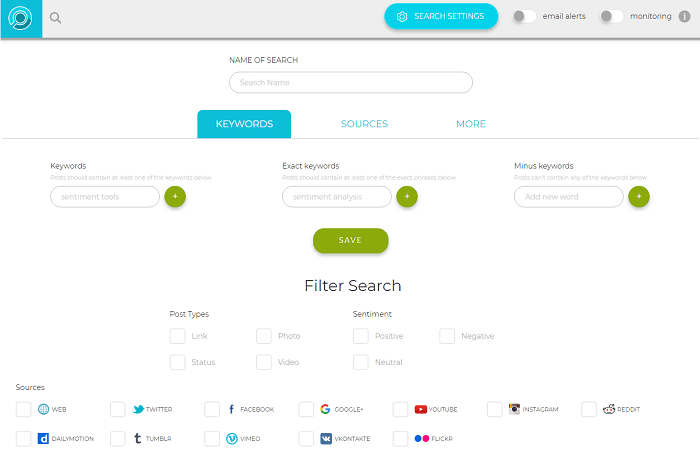10 best sentiment analysis tools Talkwalker
Best sentiment analysis tools! Track changes in feelings toward your brand. Learn what consumers think of your products.
June 9, 2022
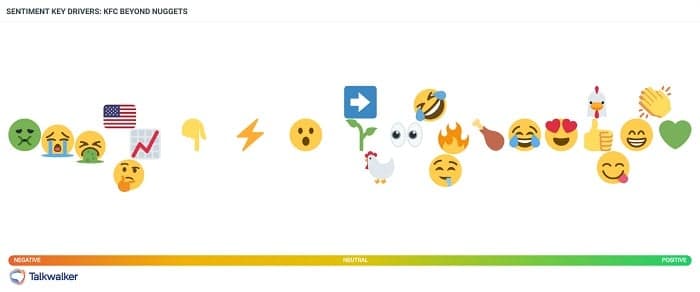
I Want My Free Sentiment Analysis Tool Demo!
Here's an example of sentiment analysis and how brands can use this tool to listen to consumers and launch new products to meet new demands. In January 2022, KFC launched plant-based fried chicken Beyond Nuggets...
KFC’s Beyond Fried Chicken tastes like scrumptious chicken… but it’s made of plants! Available for a limited time only.
— KFC (@kfc) January 10, 2022
The launch generated 15.6K social media mentions with 210K engagements...
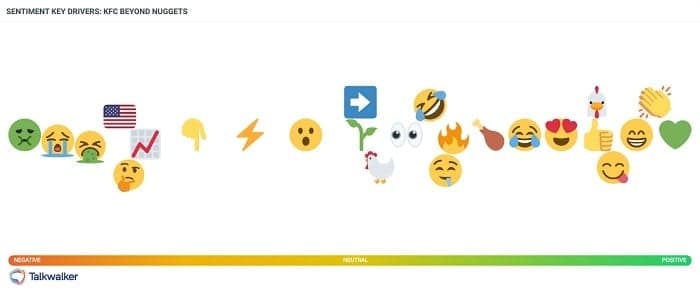
Talkwalker's sentiment analysis found that consumer sentiment was shared evenly across positive and negative.
The image shows top emoji used in conversations. Smiley faces and green hearts used to show pleasure. Green face and crying emoji demonstrating that not happy about abandoning meat. While the eyes and chicken emoji in the center show that a lot of people - brands and consumers - are monitoring sentiment surrounding plant-based meat ventures.
Sentiment analysis for your brand
Sentiment analysis is a powerful marketing tool that'll help your teams understand consumer emotions with regard to your marketing campaigns, product recognition, brand reputation, customer loyalty, customer satisfaction, and more.
The consumer insights you identify with this emotion-based marketing method will help drive your product roadmap. So you develop products and features that consumers want.
In this post, I'm going to walk you through using sentiment analysis for your brand, products, and services. Why it's essential for a successful marketing strategy, how to conduct sentiment analysis, and the best sentiment analysis tools. Click straight on down to the tools, if you can't wait.
I'll include real-life sentiment analysis examples, and you can sign up for a demo of the most accurate sentiment analysis tool on the market. First up, let's talk about why sentiment analysis is a must for customer-centric brands. I'll go into more details, later in the post…
Brand healthUnderstand how consumers feel about your brand, to identify pain points and gather user feedback about your products and services. This'll help you meet their demands, increase customer retention, and improve your product development.
Crisis managementCatch an issue before it blows up into a reputation damaging PR crisis, by monitoring and analyzing negative spikes.
Competitor analysisUse competitor analysis to find negative conversations, so you can enter the conversation and offer your product as a solution.
Improve performanceTrack reactions to your campaigns, events, product launches, to find ways to improve.
Okay, let's get into the nuts and bolts of using sentiment analysis to protect and promote your brand, products, and services.
Table of contents
Why is sentiment analysis important?
Customer feedback found on social media, review sites, forums, blog posts, is full of insights that'll fuel your marketing campaigns. Listening to the voice of the customer talking about your brand will help you understand what cosumers love about your products, and if they have any issues or new demands.
What do they love about your product? What do they hate? Monitoring consumer opinion will help you find areas that can be improved, updates to your products and features, to keep your customers happy.
Using sentiment analysis will highlight a change in consumer opinion towards your brand. For instance, you see a negative spike following your latest product launch. Find negative conversations and understand what's causing the displeasure. Slow delivery of your product? Features not up to scratch? Too expensive?

Positive or negative sentiment?
Brands use sentiment analysis to find and measure customer opinions and attitudes towards their brand, products, services, campaigns. Analyzing sentiment on social media provides an excellent source of data and will give you digital consumer insights that can...
Determine brand reputation
Improve the customer experience
Stop issues becoming a crisis
Determine future marketing strategies
Improve marketing campaigns and product messaging
Identify brand influencers
Test business KPIs
Generate leads
Cool, no? Social media sentiment analysis will improve your bottom line.
It’s more than tracking numbers. A surge in mentions could be perceived as a good thing. Particularly if you launched a new product, posted a new article, sent out a press release. But, are they positive mentions or negative?
The image above. You see the problem?
Using inaccurate sentiment analysis data can prove catastrophic. Choosing the right tool is essential. A tool that gets sarcasm. That reads the comment from John Doe and understands that it's sarcastic. So you have to choose the best. Some social media analysis vendors state that their sentiment analysis algorithm will be, at best, 50-60% accurate.
Until now...
Try The Sentiment Analysis Tool With 90% Accuracy!
What is sentiment analysis?
Sentiment analysis - opinion mining, text analysis, emotion AI - uses natural language processing - NLP - to analyze conversations and determine the emotional tone behind words, and understand the attitudes and opinions being expressed. As humans, we do this instinctively - without thinking.
What about content online?
Social media has given consumers a virtual soapbox, from where they can shout their opinions. Good and bad. While humans instantly recognize the sentiment behind a single comment, how should we cope with the explosion of content shared on social media?
Here’s some of what we’re dealing with...
6,000 tweets per second on Twitter, equalling 200 billion tweets per year
500 hours of video content uploaded to YouTube every minute
500,000+ comments posted on Facebook every minute
We need tools to help. Sentiment analysis tools use NLP to analyze online conversations and determine deeper context - positive, negative, neutral. These tools mimic our brains, to a greater or lesser extent, allowing us to monitor the sentiment behind online content.
AI-powered sentiment analysis is a hugely popular subject. It’s far too big to dig deep in this post. If you’re interested in reading in more detail, check out our - Online Sentiment Analysis Guide.
Benefits of sentiment analysis
Let's look at the benefits of sentiment analysis for your brand...
Monitor your brand's reputation
Your brand reputation is your most valuable asset. It takes time to build a strong reputation, and seconds to destroy it.
Understand the sentiment behind consumers' comments so you know how they feel about your brand and products. Changes in sentiment - positive or negative - could indicate a failed product launch, or a marketing campaign that's missed its target.
If you're struggling to protect your reputation, check out my Online Reputation Management Tools & Guide for more details.
Improved customer experience
It's vital that you understand how a consumer feels at every step of the customer journey. Are they struggling to navigate your website? Is the payment process clunky? Monitoring customer experience metrics will reveal areas that you can improve to keep your customers satisfied.
Crisis management
A shift in consumer opinion can strike fear into a brand's heart. An increase in negative mentions addressed immediately, can halt a crisis in its tracks. If, or should I say when, because we're all vulnerable, hit by a potential PR disaster, analyzing consumer sentiment and filtering the mentions by severity of negativity, means you'll be able to target your messaging. Conversations that express positive sentiment, can be amplified to take the heat out of the issue. We trust user-generated content, use it.
Competitive benchmarking
Understand how your brand compares with your competitors, with regard to sentiment. How are your marketing campaigns affecting consumers' perception of your brand, in comparison to your competition? If you find negative sentiment hitting a competitor, can you steer conversation towards your product?
Take a look at my Competitive Analysis Guide, to understand how to benchmark against your competition.
Find the best influencers
It's not just consumers that are sharing their opinions online. Find influencers that are raving about your products like yours. Search for keywords related to your industry, to find potential brand advocates that are discussing topics related to your industry. Reach out and build a relationship with those that are talking positively.
Customer service
Analyzing customer sentiment will help your customer support team track customer satisfaction/dissatisfaction. Enabling the team to address any issues before they escalate.
Monitor review sites, to find positive and negative reviews. Turn around any negative comments, and you're demonstrating to other consumers that you care about your customers. You may even earn positive user-generated content.
Here’re some awesome sentiment analysis tools. Take them for a spin!
Types of sentiment analysis
There are four methods adopted by most providers...
Keyword scoring
Calculation based on predefined categories
Humans - yep, you and me
Then there's Talkwalker
Keyword scoring
Sentiment analysis using keyword scoring gives negative or positive scores. For instance, the word 'good' would score positive, and the word 'bad' would score negative. Unfortunately, language has evolved...
I LOVE YOU SO BAD I LOVE YOU SO BAD I LOVE YOU SO BAD I LOVE YOU SO BAD I LOVE YOU SO BAD I LOVE YOU SO BAD I LOVE Y pic.twitter.com/ZW5WGnf9tJ
— troye (@troyesivan) October 24, 2015
See the problem?
There are advantages though. It's fast, predictable, and it's cost effective. You can apply rules, but you can't always rely on the results if used too broadly. Why? Because keyword scoring sentiment analysis doesn't understand sarcasm or slang. Plus, there's potential for human error if the developer designating the percentages, has a different idea about whether a word is positive or negative.
That's sick!
Accuracy levels are between 50 to 80%, which aren't strong enough to make data-driven business decisions.
Predefined categories
The predefined categories method has users categorizing multiple results, to create a training set. An algorithm is then used to determine future analysis. The level of accuracy is higher than with keyword scoring, but it's not perfect. It takes a lot of man hours, and the number of results are less.
It's not a cost effective method, when you consider the time it takes to retrieve a handful of results.
Humans
Humans. We're the best. We get sarcasm and slang. Therefore, this method is great.
The draw back is how long it takes. And, because it's slow, trying to find comments with negative sentiment and stop it escalating to a crisis, is a dangerous game to play.
The results are awesome. Although, humans interpreting humans can be subjective. Plus, with so much consumer conversation happening every second of every day, there's way too much content for humans to analyze without some kind of automation tool.
AI-powered sentiment analysis
Yep. I'm talking Talkwalker.
Talkwalker's Blue Silk™ AI technology drives our sentiment analysis prioritizing the mentions to focus on. I'm talking about the true meaning, with an average 90% accuracy, from 127+ l****anguages. It gets sarcasm. It gets slang.
We use deep learning models to simulate the cognitive functions of the human brain, to understand language patterns and basic sarcasm, irony, and slang. To achieve an accuracy rate of nearly 90%, our data science team classified tens of millions of results.
Result!
Sentiment analysis tools
Talkwalker | Social media search engine
Talkwalker's Blue Silk™ AI-enable sentiment analysis tool gives you an instant overview of your brand online. It’s a social media search engine that offers extensive coverage of social networks - including news sites, blogs, and forums.
Let's look a a real-life example...
To celebrate diversity, the LEGO Group recently launched a new set - Everyone is Awesome.
We’re super excited to reveal our new set - LEGO Everyone is Awesome! Because we celebrate every LEGO builder ❤️ #LEGO #EveryoneIsAwesome pic.twitter.com/J7KSz3zWik
— LEGO (@LEGO_Group) May 20, 2021
Its launch was timed to coincide with the upcoming Pride month. This new set, inspired by the rainbow flag adopted by the LGBTQ+ community, went viral with 41K engagements. Check out the virality map from Talkwalker Analytics...
Market Pulse - LEGO's announcement quickly went viral with 41K global engagements in two days.
LEGO can use sentiment analysis to see that conversation around this awesome new product earned 64% positive sentiment, as people shared their excitement and celebrated the launch.
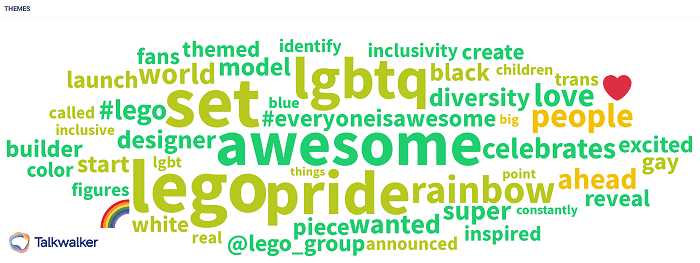
Sentiment analysis looking at conversations on social media - mostly positive comments with the rainbow and heart emojis leading conversations.
Features include...
Quick brand overview - the KPIs that matter - engagement, volume, sentiment, demographics, and geographies
Find real-time trends - identify emerging trends to boost your content
Content ideation - create viral content that resonates with your audience
Competitive intelligence - compare multiple brands to benchmark against competitors
HubSpot | Customer feedback software
HubSpot's Service Hub offers a customer feedback tool that evaluates survey responses to detect positive or negative intent. Using Net Promoter Score® - NPS - it determines whether a customer review is good or bad, then ranks them according to sentiment.
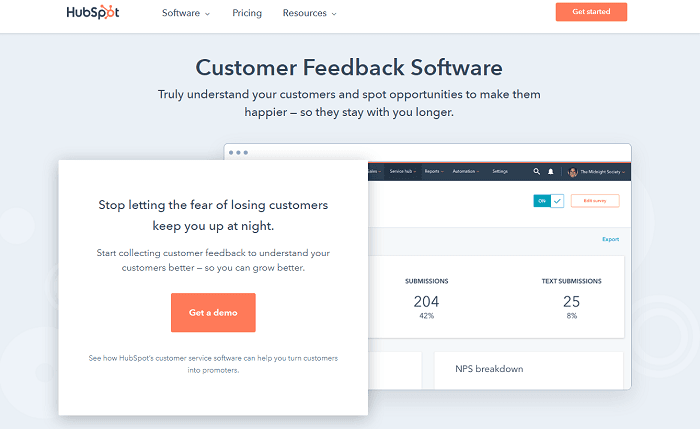
Understand your customers and spot opportunities to make them happier, so they stay longer.
You can see the results on a single dashboard that uses data visualizations to give an overview of customer satisfaction.
The Service Hub suite also analyzes individual customers, and can be integrated with your CRM. This means your team can identify customers who are dissatisfied and address their issues immediately.
Features include...
Gauge customer loyalty over time with NPS
Customer effort score - CES - surveys
Customer satisfaction - CSAT - surveys
Find opportunities to improve customer experience
Identify trends to improve your customer service
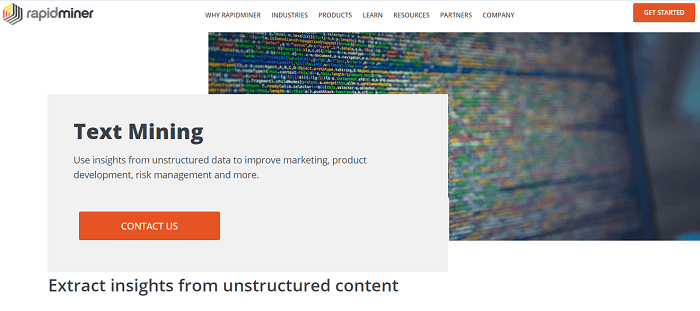
| Sentiment Viz
This is a cool freebie for Twitter sentiment analysis. Type in your keyword and the Tweet Visualizer pulls out recent tweets for the past week. Note that the time range is shorter for more popular subjects.

Great free sentiment analysis tool for Twitter.
When you hover your cursor over a dot, you can see individual tweets from identified Twitter users, and see where they appear on the sentiment spectrum.
You have a choice of views...
Sentiment - emotion in the tweet is estimated - blue indicates negative, green for positive
Topics - automatically clusters tweets into related topics by with machine-learning algorithms
Heatmap - a grid with mapped tweets - red for more than average number, blue for less

Heatmap - a grid for mapped tweets.
Measuring pleasure, activation, and dominance.
Tag Cloud - common words indicating emotion, with the more frequently used displayed larger
Timeline - the number of tweets and when they were posted - green for good, blue for not so good

Green for good. Blue for - meh - not so good.
Map - location of posted tweets on world map
Affinity - frequent tweets, people, hashtags, and URLs
Narrative - time-ordered sequence of tweets that form conversations
Tweets - listed by date, author, sentiment, and content
The tool uses a pleasure and arousal rating to estimate sentiment for an entire tweet. For a free tool, it’s great. For a free tool, there are limitations. It will struggle with slang and sarcasm. But, it’s absolutely worth taking a look at.
Sentiment Viz offers far more than can be found on most other free sentiment analysis tools.
MeaningCloud | Global polarity value
The sentiment analysis API implements a detailed, multilingual analysis of content from several sources. Determining if it displays positive, negative, or neutral sentiment - or if not possible to detect. Phrases are identified with the relationship between them evaluated. This identifies a global polarity value of the text.
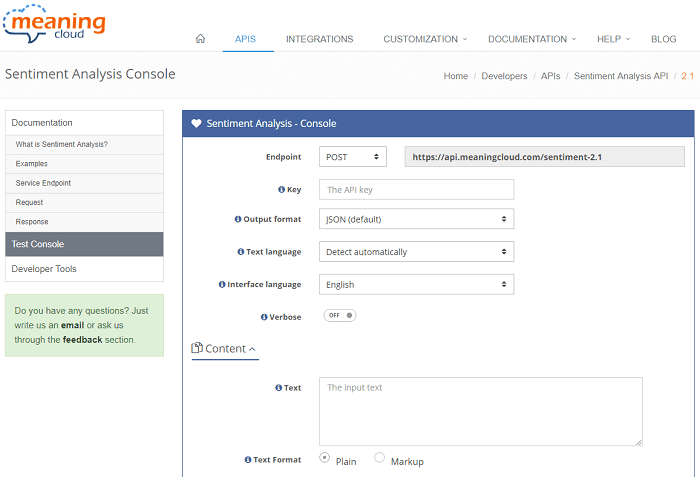
Multilingual analysis of content from several souces, with custom dictionaries for sentiment classification.
Features include:
Global sentiment - general opinion expressed in tweets, blog posts, reviews
Sentiment at attribute level - analyzes the specific sentiment of each sentence
Identification of opinions and facts - distinguishes between objective and subjective
Detection of irony - identifies comments where sentiment is opposite to what’s said
Graduated polarity - rates from very negative to very positive
Agreement and disagreement - identifies opposing opinions - contradictory, ambiguous
This sentiment analysis tool allows users to upload custom dictionaries for use in sentiment classification, and there’s also an Excel add-in for Windows. Languages currently covered are English, Spanish, French, Italian, Catalan, and Portuguese.
Social Mention | 100+ social platforms
A real-time search platform, that while basic, monitors 100+ social platforms including FriendFeed, YouTube, Digg, and Google+. Plus, blogs and news sites. It aggregates user-generated content, allowing you to track and measure what consumers are saying about your brand.
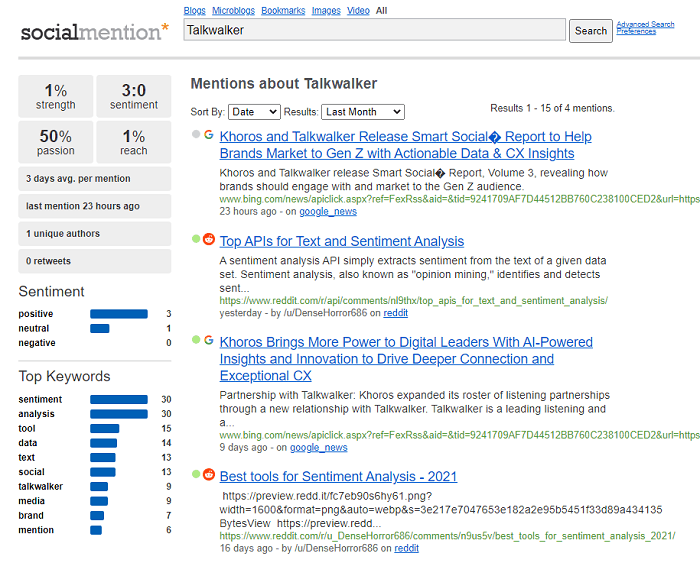
Real-time sentiment analysis tool, monitoring 100+ social platforms.
Easy to use, type in your brand, industry, competitor and let Social Mention do the rest. The report you’ll receive ranks results by sentiment - positive, negative, neutral - top keywords, top users, top hashtags, and sources.
It’s free and it gives a lot. Just don’t expect pretty.
Sentiment Analyzer | Computational linguistics
This sentiment analysis tool uses computational linguistics and text mining to identify the sentiment behind text.
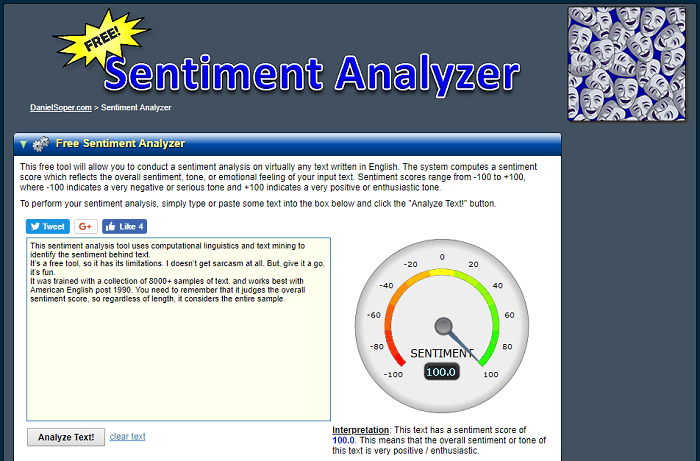
No sarcasm? No way! But useful, nonetheless.
It’s a free sentiment analysis tool, so it has its limitations. It doesn’t get sarcasm at all. But, give it a go, it’s fun.
It was trained with a collection of 8000+ samples of text, and works best with American English post-1990. You need to remember that it judges the overall sentiment score, so regardless of length, it considers the entire sample.
SentiStrength | 16,000 social texts per second
SentiStrength is a free sentiment analysis tool for academic research. Although, you can apply and pay for the commercial Java version or license for the online version. The free tool runs on Windows only.
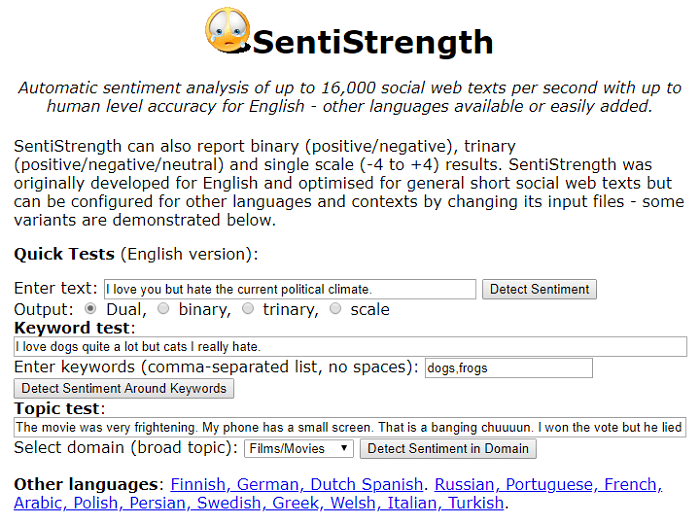
Not a pretty site, but heaps of interesting stuff to read.
It offers automatic sentiment analysis of up to 16,000 social web texts per second, with - it claims - human level accuracy for English.
SentiStrength reports two sentiment strengths:
-1 (not negative) to -5 (extremely negative)
1 (not positive) to 5 (extremely positive)
Why two scores? Apparently, research has revealed that humans process positive and negative sentiment in parallel - mixed emotions.
The website ain’t pretty, but there’s a lot of interesting stuff to read. Including several case studies. I’d suggest you take a look and see the tool in action.
Rosette | AI for human language
Machine learning models are trained on tweets and reviews, to find positive and negative sentiment. Using entity extraction, Rosette text analytics can analyze a review mentioning several brands, and determine the sentiment related to each one. This sentiment analysis tool comes with 6 prebuilt languages, but you have the option to teach Rosette new languages.
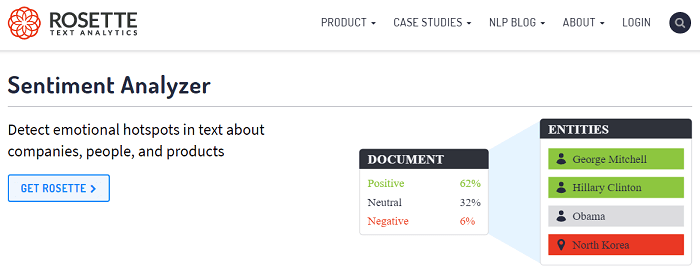
Find emotional hotspots in text about companies, people, and products.
Features include...
6 supported languages
18 detected entity types
Classification field training kit
Cloud and enterprise deployments
Top quality support
Rosette also includes a chat translator, name translator, semantic similarity, topic extractor, and more.
Give it a go!
